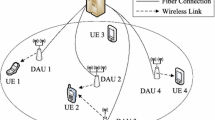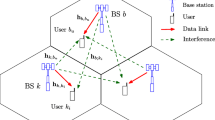Abstract
Green communication attracts more and more attention and energy efficiency is becoming an important performance evaluation for the future generations of wireless networks. This paper aims to investigate the optimal energy-efficient design for downlink multi-cell multi-antenna OFDMA environment with coordinated scheduling and beamforming. We target at maximizing the energy efficiency of the whole network subject to the power constraint for each base station and the maximum co-channel interference limitation. At the solving stage, we propose an improved binary search approach (IBSA) which is superlinear convergent and can provide explicit optimal range at every iteration. A joint scheduling and beamforming algorithm is further developed to solve the secondary problem embedded in each iteration of IBSA. Simulation results demonstrate that the proposed algorithm has fast convergent rate and achieves significant performance gain in energy efficiency for cellular network.




Similar content being viewed by others
References
Gesbert, D., Kiani, S. G., Gjendemsjø, A., & Øien, G. E. (2007). Adaptation, coordination, and distributed resource allocation in interference-limited wireless networks. Proceedings of the IEEE, 95(12), 2393–2409.
Hassan, M. H., Fahmy, Y. A., & Khairy, M. M. (2013). Phase ambiguity mitigation for per-cell codebookbased limited feedback coordinated multi-point transmission systems. IET Communications, 6(15), 2378–2386.
Sawahashi, M., Kishiyama, Y., Morimoto, A., Nishikawa, D., & Tanno, M. (2010). Coordinated multipoint transmission/reception techniques for LTE-advanced. IEEE Wireless Communications, 17(3), 26–34.
Venturino, L., Prasad, N., & Wang, X. D. (2009). Coordinated scheduling and power allocation in downlink multicell OFDMA networks. IEEE Transactions on Vehicular Technology, 6(58), 2835–2848.
Wang, T., & Vandendorpe, L. (2011). Iterative resource allocation for maximizing weighted sum min-rate in downlink cellular OFDMA systems. IEEE Transactions on Signal Processing, 1(59), 223–234.
Xiang, Z. Z., Tao, M. X., & Wang, X. D. (2013). Coordinated multicast beamforming in multicell networks. IEEE Transactions on Wireless Communications, 1(12), 12–21.
Li, W. C., Chang, T. H., Lin, C., & Chi, C. Y. (2013). Coordinated beamforming for multiuser MISO interference channel under rate outage constraints. IEEE Transactions on Signal Processing, 5(61), 1087–1103.
Xie, R., Yu, F. R. & Ji, H. (2012). Energy-efficient spectrum sharing and power allocation in cognitive radio femtocell networks. In Proceedings of IEEE INFOCOM (pp. 1665–1673), Orlando.
Kwon, H. M., & Birdsall, T. G. (1986). Channel capacity in bits per joule. IEEE Journal Oceanic Engineering, 11(1), 97–99.
Heliot, F., Imran, M. A. & Tafazolli, R. (2011). Energy efficiency analysis of idealized coordinated multi-point communication system. In Proceedings of IEEE vehicular technology conference (pp. 1550–2252), Yokohama, Japan.
Cili, G., Yanikomeroglu, H., & Yu, F. R. (2012). Cell switch off technique combined with coordinated multi-point (CoMP) transmission for energy efficiency in beyond-LTE cellular networks. In Proceedings of IEEE international conference on communications (ICC) (pp. 5931–5935), Ottawa.
Ng, D. W. K., Lo, E. S., & Schober, R. (2012). Energy-efficient resource allocation in multi-cell OFDMA systems with limited backhaul capacity. IEEE Transactions on Wireless Communications, 11(10), 3618–3631.
Wang, X. M., Zhu, P. C., Sheng, B., & You, X. H. (2013). Energy-efficient downlink transmission in multi-cell coordinated beamforming systems. In Proceedings of IEEE wireless communications and networking conference (WCNC) (pp. 1525–3511), Shanghai.
Cover, T. M., & Thomas, J. A. (1991). Elements of information theory. New York: Wiley Press.
Arnold, O., Richter, F., Fettweis, G., & Blume, O. (2010). Power consumption modeling for different base station types in heterogeneous cellular networks. In Proceedings of future network and mobile summit (pp. 1–8), Florence.
Heliot, F., Imran, M. A., & Tafazolli, R. (2011). Energy efficiency analysis of idealized coordinated multi-point communication system. In Proceedings of IEEE vehicular technology conference (pp. 1–5), Yokohama.
Fehske, A., Marsch, P., & Fettweis, G. (2010). Bit per joule efficiency of cooperating base stations in cellular networks. In Proceedings of IEEE GLOBECOM (pp. 1406–1411), Miami, FL.
Dinkelbach, W. (1967). On nonlinear fractional programming. Management Science, 13(7), 492–498.
Li, Y. Z., Sheng, M., Yang, C. G., & Wang, X. J. (2013). Energy efficiency and spectral efficiency tradeoff in interference-limited wireless networks. IEEE Communications Letters, 17(10), 1924–1927.
Toshihide, I. (1983). Parametric approaches to fractional programs. Mathematical Programming, 26(3), 345–362.
Boyd, S., & Vandenberghe, L. (2004). Convex optimization. London: Cambridge University Press.
E3, T3 and HSSI Manageable fiber optic modems. http://www.rad-direct.com/datasheet/fomie3t3
Schaible, S. (1976). Fractional programming II, on Dinkelbach’s algorithm. Management Science, 22(8), 868–873.
Acknowledgments
This work was supported by the National Natural Science Foundation of China under Grant (No. 61271299), by the 111 Project (No. B08038) and supported by the Fundamental Research Funds for the Central Universities (No. K5051301034).
Author information
Authors and Affiliations
Corresponding author
Appendices
Appendix 1
Theorem 2
The proposed IBSA is superlinear convergent.
Proof
First, let \(\{{q_i}\}\) indicate the sequence generated by IBSA. According to the relative position with \({q^*}\), \(\{{q_i}\}\) can be decomposed into three subsequences: \(\{ q_j^a\}\) consisting of the elements satisfying \(f({q_i})>0\), \(\{ q_j^b\}\) consisting of the elements satisfying \(f({q_{i - 1}})<0\) and \(f({q_i})<0\), \(\{ q_j^c\}\) consisting of the rest of elements. From the above definition, if \({q_i}\) pertains to \(\{q_j^c\}\), \({q_{i - 1}}\) pertains to \(\{ q_j^a\}\) and \({q_{i + 1}}\) pertains to \(\{ q_j^a\}\) or \(\{ q_j^b\}\).
Next, we will prove the superlinear convergence of subsequence \(\{ q_j^a\}\). For \(q_j^a < {q^*},\forall j\), we can resort to the conclusion in [23] and obtain
where \(\{{\mathcal {W}^j}, {\mathcal {X}^j}\} \) is the optimal solution of (11) with \(q = q_j^a\). From the mechanism of IBSA, we have \({{R({\mathcal {W}^j},{\mathcal {X}^j})} \big /{{P_T}({\mathcal {W}^j},{\mathcal {X}^j})}} < q_{j + 1}^a\), and furthermore obtain
The optimal range gets smaller as algorithm continues, and \(q_j^a \rightarrow {q^*}\) as \(j\rightarrow \infty \). Since f(q) is continuous and \(-{P_T}(\mathcal {W},\mathcal {X})\) is gradient of f(q), it can be easily observed that \({P_T}({\mathcal {W}^j},{\mathcal {X}^j}) \rightarrow {P_T}({\mathcal {W}^*},{\mathcal {X}^*})\) as \(q_j^a \rightarrow {q^*}\). Thus, \(({{{q^*} - q_{j + 1}^a)} \big / {({q^*} - q_j^a}}) \rightarrow 0\) as \(j\rightarrow \infty \).This completes the superlinear convergence proof for \(\{ q_j^a\}\). Now we turn to the superlinear convergence proof for \(\{q_j^b\}\).
Assume \(q_{j + 1}^b = {q_i}\), we have \({q^*} < {q_i} < {q_{i - 1}} \leqslant q_j^b\) from the definition of \(\{q_j^b\}\), and
Since \(i\rightarrow \infty \) as \(j\rightarrow \infty \) and \(\varepsilon (\infty ) = \infty \), we have \(({{q_{j + 1}^b - {q^*})}\big / {(q_j^b - {q^*}}}) \rightarrow 0\) as \(j\rightarrow \infty \).
A subsequence \(\{{\hat{q}_k}\}\) of \(\{ {q_i}\}\) generated by IBSA can be constructed like this: if \({\hat{q}_k} = {q_i}\), \({\hat{q}_{k + 1}} = {q_{i + 1}}\;or\;{q_{i + 2}}\). This subsequence can be decomposed into \(\{ q_j^a\}\) and \(\{ q_j^b\}\), each of which converges superlinearly to \({q^*}\) from below and above respectively. Therefore, the sequence generated by IBSA substantially is constitutive of two subsequences with superlinear convergent property and the theorem 2 is proved.
Appendix 2
Theorem 3
Let the initial interval \({q^u}(1) - {q^l}(1) = L\), the value range obtained by IBSA after m iterations satisfies
where \({q^u}(m)\) and \({q^l}(m)\) are the upper and lower bound obtained in the m th iteration.
Proof
The proof should be considered under the following four conditions covering all the possible cases.
-
1.
If \(f({q_{i - 2}}) < 0\) and \(f({q_{i - 1}}) < 0\), that is, \({q_{i - 1}} \in \{ {q_j^b}\}\). From the process of Algorithm 1, we have
$$\begin{aligned} {q_{i - 1}} = \frac{1}{{\varepsilon (i - 1)}}{q^u}(i - 1) + \frac{{\varepsilon (i - 1) - 1}}{{\varepsilon (i - 1)}}{q^l}(i - 1). \end{aligned}$$(34)Since \({q^l}(i) = {q^l}(i - 1)\) and \({q^u}(i) = i({q^l}(i - 1),{q_{i - 1}})\), we obtain
$$\begin{aligned} {q^u}(i) - {q^l}(i) \leqslant {q_{i - 1}} - {q^l}(i - 1) = \frac{1}{{\varepsilon (i - 1)}}({q^u}(i - 1) - {q^l}(i - 1)). \end{aligned}$$(35)The same procedure may be easily adapted to obtain the other three conclusions.
-
2.
If \(f({q_{i - 2}}) < 0\) and \(f({q_{i - 1}}) > 0\), then \({q^u}(i) - {q^l}(i) \leqslant \frac{{\varepsilon (i - 1) - 1}}{{\varepsilon (i - 1)}}({q^u}(i - 1) - {q^l}(i - 1))\).
-
3.
If \(f({q_{i - 2}}) > 0\) and \(f({q_{i - 1}}) < 0\), that is, \({q_{i - 1}} \in \{ {q_j^c}\}\), then \({q^u}(i) - {q^l}(i) \leqslant \frac{{\varepsilon (i - 1) - 1}}{{\varepsilon (i - 1)}}({q^u}(i - 1) - {q^l}(i - 1))\).
-
4.
If \(f({q_{i - 2}}) > 0\) and \(f({q_{i - 1}}) > 0\), then \({q^u}(i) - {q^l}(i) \leqslant \frac{1}{{\varepsilon (i - 1)}}({q^u}(i - 1) - {q^l}(i - 1))\).
Since \(\varepsilon (t) \ge 2\), the maximum upper bound of \({q^u}(m) - {q^l}(m)\) is \(L \cdot \prod \nolimits _{t = 1}^m {[{{(\varepsilon (t - 1) - 1)} / {\varepsilon (t - 1)}}]}\), which achieves as case ii and iii happens alternately. This completes the proof.
Rights and permissions
About this article
Cite this article
Tong, Z., Li, B. & Hui, Y. Joint Scheduling and Beamforming for Energy Efficiency Maximization in Downlink Coordinated Multi-Cell Networks. Wireless Pers Commun 85, 1333–1350 (2015). https://doi.org/10.1007/s11277-015-2843-y
Published:
Issue Date:
DOI: https://doi.org/10.1007/s11277-015-2843-y




